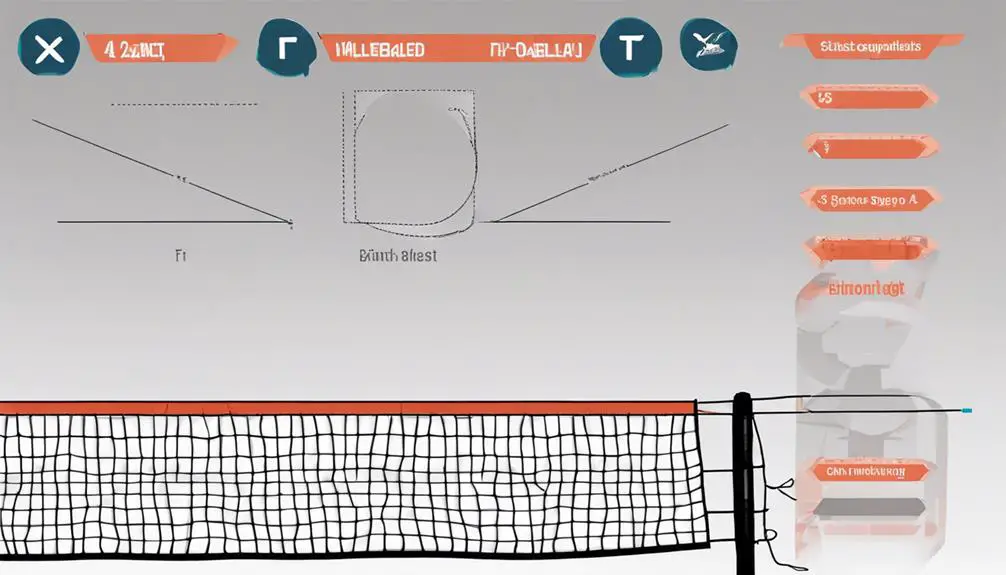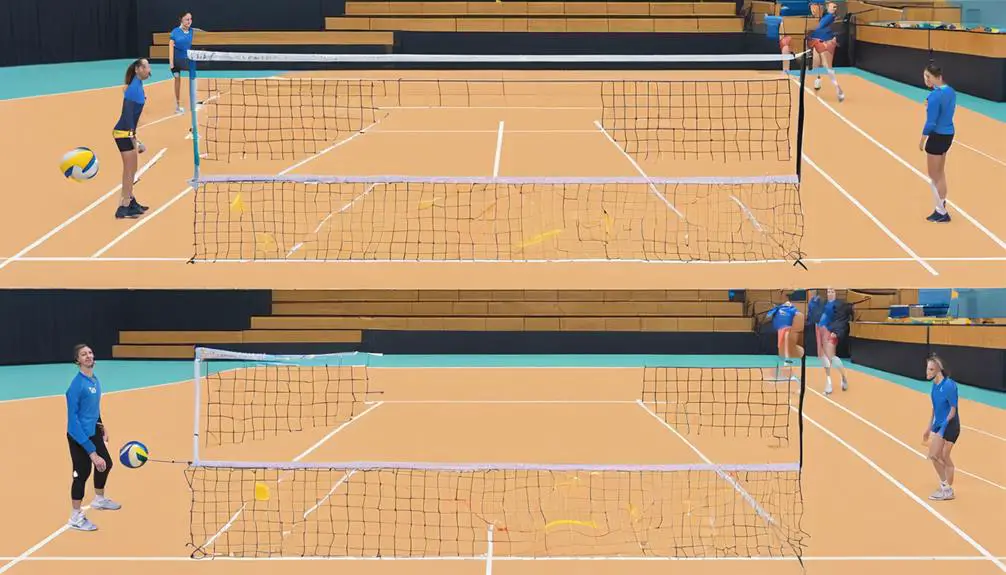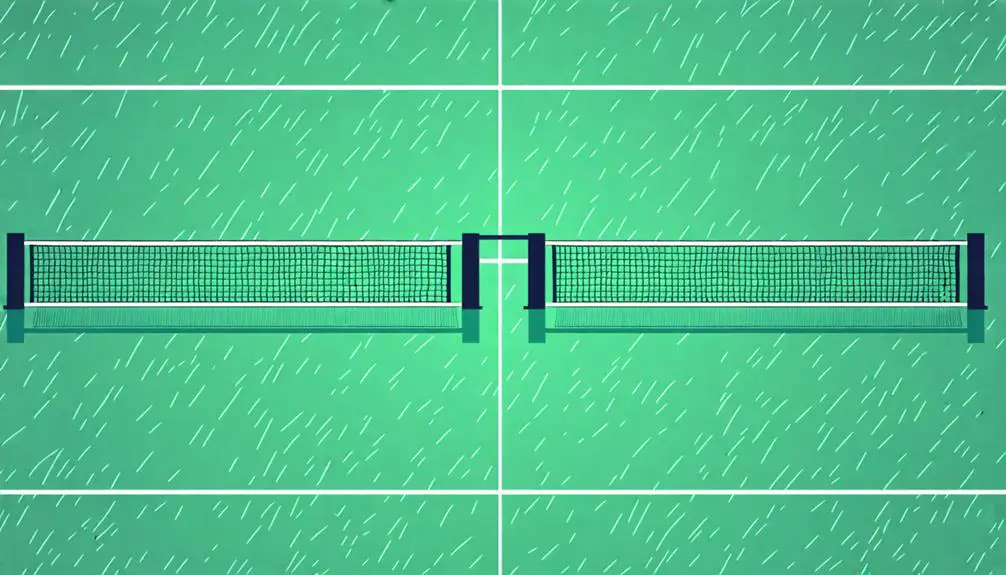When setting up a net for your next game, you'll notice significant differences between a volleyball net and a badminton net. Volleyball nets stand at 2.43 meters (8 feet) for men's play, while badminton nets are fixed at 1.55 meters (5 feet). The nets also vary in width, with volleyball nets spanning 9.75 meters (32 feet) and badminton nets approximately 6.1 meters (20 feet) wide. Material and tension requirements also differ, with volleyball nets made from heavier-duty materials and requiring thicker cords for tension adjustment. Exploring the specifics of each net type can help you guarantee safe and enjoyable gameplay.
Height and Design Differences

When comparing the nets used in volleyball and badminton, height is one of the most noticeable differences. You'll find that a badminton net stands at 1.55 meters (5 feet) at the center, while a men's volleyball net towers over it at 2.43 meters (8 feet). This remarkable height difference is an essential aspect of each sport, reflecting the distinct requirements of the games.
Beyond height, the design of the nets also varies considerably. Badminton nets feature smaller holes to prevent the shuttlecock from passing through, whereas volleyball nets have larger holes to accommodate the size of a volleyball. This design difference is a direct response to the unique characteristics of each sport's projectile. Additionally, the width of the nets differs, with badminton nets measuring approximately 20 feet (6.1 meters) and volleyball nets stretching to around 32 feet (9.75 meters).
In addition to these physical differences, the adjustability of the nets also sets them apart. While badminton nets have a fixed height, volleyball nets can be adjusted based on the gender and level of play, adhering to specific regulations. This adjustability reflects the varying requirements of volleyball's different competitive levels and the need for a more nuanced approach to the game. By understanding these height and design differences, you'll gain a deeper appreciation for the distinct demands of volleyball and badminton nets.
Materials and Tension Explained
Delving into the composition of volleyball and badminton nets, you'll find that the materials used in their construction differ considerably. Badminton nets are primarily made from polyester and nylon blends, providing flexibility and resilience against the impact of shuttlecocks. In contrast, volleyball nets are constructed from heavier-duty materials, often reinforced with wire to withstand powerful volleys.
The net system for each sport also varies regarding tensioning. Volleyball nets require a thick cord along the top and bottom for proper tension adjustment, ensuring the net remains taut during play. Badminton nets, on the other hand, typically only require top tension to maintain their regulated height. Here are three key differences in the materials and tensioning of badminton and volleyball nets:
- Materials: Badminton nets feature a specific weave material with smaller holes to prevent the shuttlecock from passing through, while volleyball nets have larger holes accommodating the larger size of the volleyball.
- Tensioning: Volleyball nets require a more complex tensioning system, with a thick cord along the top and bottom, whereas badminton nets only require top tension.
- Reinforcement: Volleyball nets are often reinforced with wire to withstand powerful volleys, whereas badminton nets rely on the flexibility and resilience of their polyester and nylon blends.
Proper tension and material choice are essential for gameplay quality, and incorrect net specifications can disrupt the dynamics of each sport. As a result, using sport-specific nets is vital for fair play.
Net Dimensions and Standards

You've gained a solid understanding of the materials and tensioning systems used in volleyball and badminton nets, but another key aspect to contemplate is the dimensions and standards that govern their setup. When it comes to net dimensions, volleyball and badminton have distinct requirements. A volleyball net stands at 2.43 meters (8 feet) high for men's play and 2.24 meters (7.4 feet) for women's play, while a badminton net is fixed at 1.55 meters (5 feet) high at the center. The length of a volleyball net is approximately 9.75 meters (32 feet), and it can be adjusted in height. In contrast, badminton nets are typically 6.1 meters (20 feet) wide and have a regulated length.
The standards for net dimensions also dictate the size of the holes in the net. Volleyball nets have larger holes to accommodate the size of the ball, while badminton nets have smaller holes designed to prevent the shuttlecock from passing through. Additionally, volleyball nets require a thick cord along the top and bottom for tension adjustment and stability, whereas badminton nets only need a top cord for tension. Understanding these net dimensions and standards is essential for setting up a regulation-compliant court. You must adhere to specific height adjustments based on gender and level of play for volleyball nets, while badminton nets are standardized in height and width with no gaps between the net and posts.
Interchangeability and Safety Concerns
Considering the distinct dimensions and standards for volleyball and badminton nets, it becomes apparent that these nets are not interchangeable. You can't simply swap one for the other and expect a fair and safe game. The significant height difference alone – 2.43 meters (8 feet) for volleyball nets versus 1.55 meters (5 feet) for badminton nets – makes them unsuitable for each other's gameplay dynamics.
The structure and tension requirements of badminton nets aren't designed to handle the forces generated in a volleyball game, and vice versa. Using the incorrect net can disrupt gameplay and fairness, leading to potential safety hazards for players. Imagine the risks involved:
Key Safety Concerns with Interchanged Nets
- Inadequate net tension: A badminton net's lower tension can't withstand the impact of a volleyball, causing it to sag or collapse, and potentially injuring players.
- Insufficient net height: A volleyball net's height can lead to badminton players hitting the net or getting entangled in it, increasing the risk of accidents.
- Poor visibility and obstruction: The larger holes in a volleyball net can allow the shuttlecock to pass through, obstructing gameplay and potentially causing eye injuries.
Compliance with sport-specific regulations concerning net specifications is essential to guarantee player safety and maintain the integrity of the game. Don't compromise on safety – use the right net for the right game to prevent unnecessary risks and create a fun, injury-free experience for all players involved.
Choosing the Right Net Type

Anyone looking to set up a net for a game of volleyball or badminton faces an important decision: selecting the right type of net. You'll need to take into account the specific dimensions and materials required for each sport to guarantee compliance with regulations and optimize the playing experience. A volleyball net, for instance, is typically 32 feet wide and 2.43 meters high for men's play, while a badminton net is narrower at 20 feet wide and fixed at a height of 1.55 meters.
The Laws of Badminton dictate the precise dimensions and tension requirements for badminton nets, so it's vital to choose a net that meets these standards. On the other hand, a volleyball court requires a net that can withstand powerful volleys, making heavier-duty materials and adjustable tension a necessity. Using a volleyball net for badminton or vice versa can disrupt gameplay due to the height and structural differences between the two types of nets.
When selecting a net, you'll also need to take into account the material and tension requirements. Volleyball nets require thicker cords for adjustable tension, while badminton nets only require tension at the top to prevent sagging. By understanding the specific needs of each sport, you can choose the right net type and guarantee a safe and enjoyable playing experience. Ultimately, the right net will allow you to focus on your game, unencumbered by the constraints of an ill-suited net.
Frequently Asked Questions
Can You Use the Same Net for Volleyball and Badminton?
You can't use the same net for both sports; it's not a matter of preference, but rather a requirement of game regulations. Net specifications, including height, width, and material, are designed to meet the unique demands of each game. Using the wrong net can compromise fairness and safety. To enjoy the freedom to play either sport, you need to adhere to the specific net requirements for each, ensuring a fun and competitive experience.
Can We Play Volleyball in a Badminton Court?
You're considering playing volleyball in a badminton court? That's a tight squeeze – badminton courts are 20×44 feet, whereas volleyball courts are 30×60 feet. Due to these court dimensions, you'll need to adjust your gameplay to accommodate the smaller space. The game rules will also need to be modified to guarantee player safety and accommodate the faster exchanges typical of badminton. Unfortunately, it's not an ideal setup for a fun and safe volleyball game.
How Is the Difference Between Volleyball and Badminton?
You're likely wondering how volleyball and badminton differ beyond the net. The truth is, the two sports have distinct game rules and scoring systems. Volleyball is typically played best two out of three sets, while badminton is played best two out of three games with a 21-point scoring system. You'll also notice differences in serves, volleys, and lets. Mastering these nuances will give you the freedom to excel in either sport.
What Net Is Used in Badminton?
You can't hit a home run without knowing the playing field, and in badminton, the net is the key. A badminton net's specifications are precise: 1.55 meters (5 feet) high at the center, with a width of approximately 20 feet (6.1 meters). The net's height is essential, as it requires players to hit the shuttlecock with finesse. Familiarize yourself with these specs, and you'll be serving up aces in no time.




